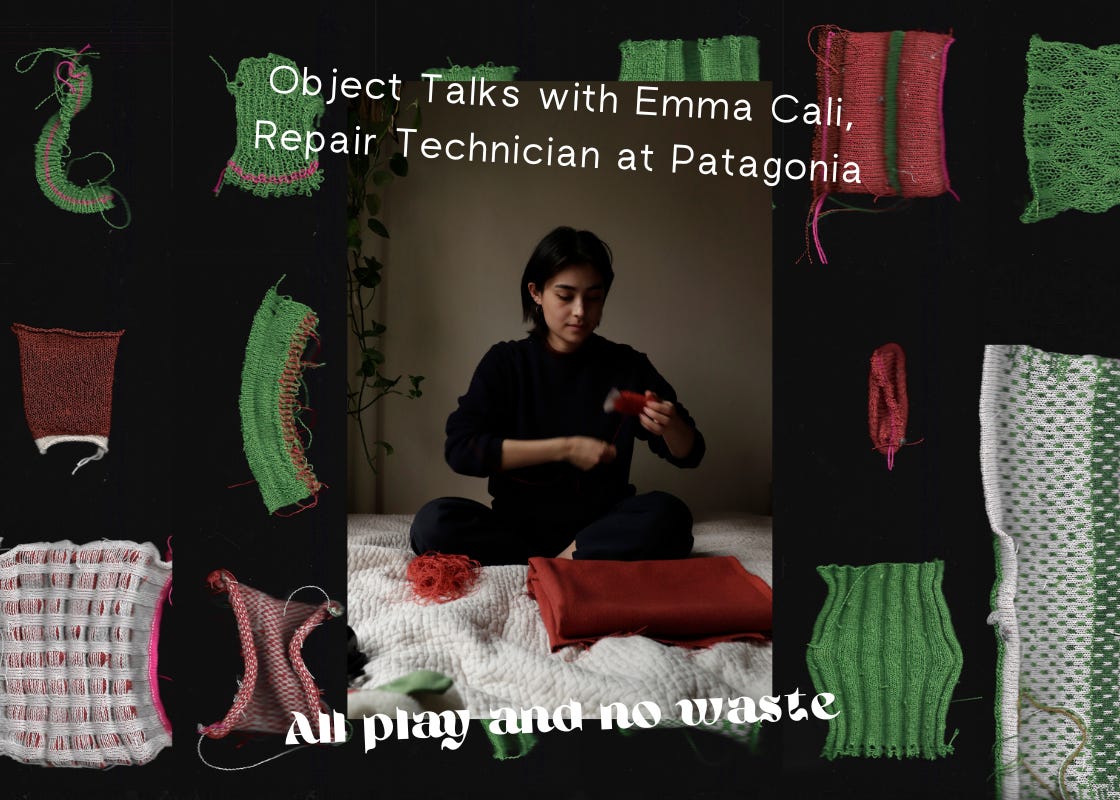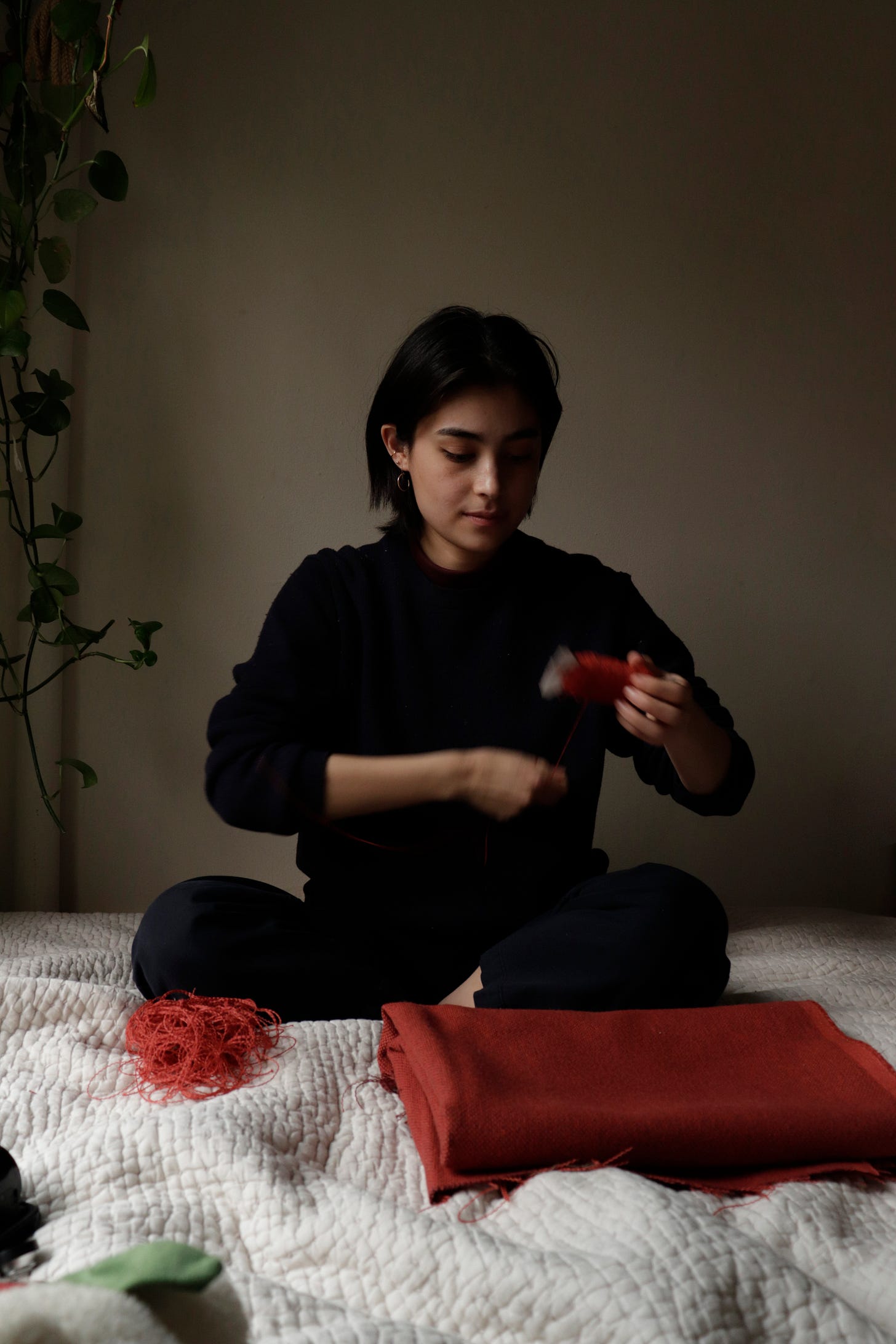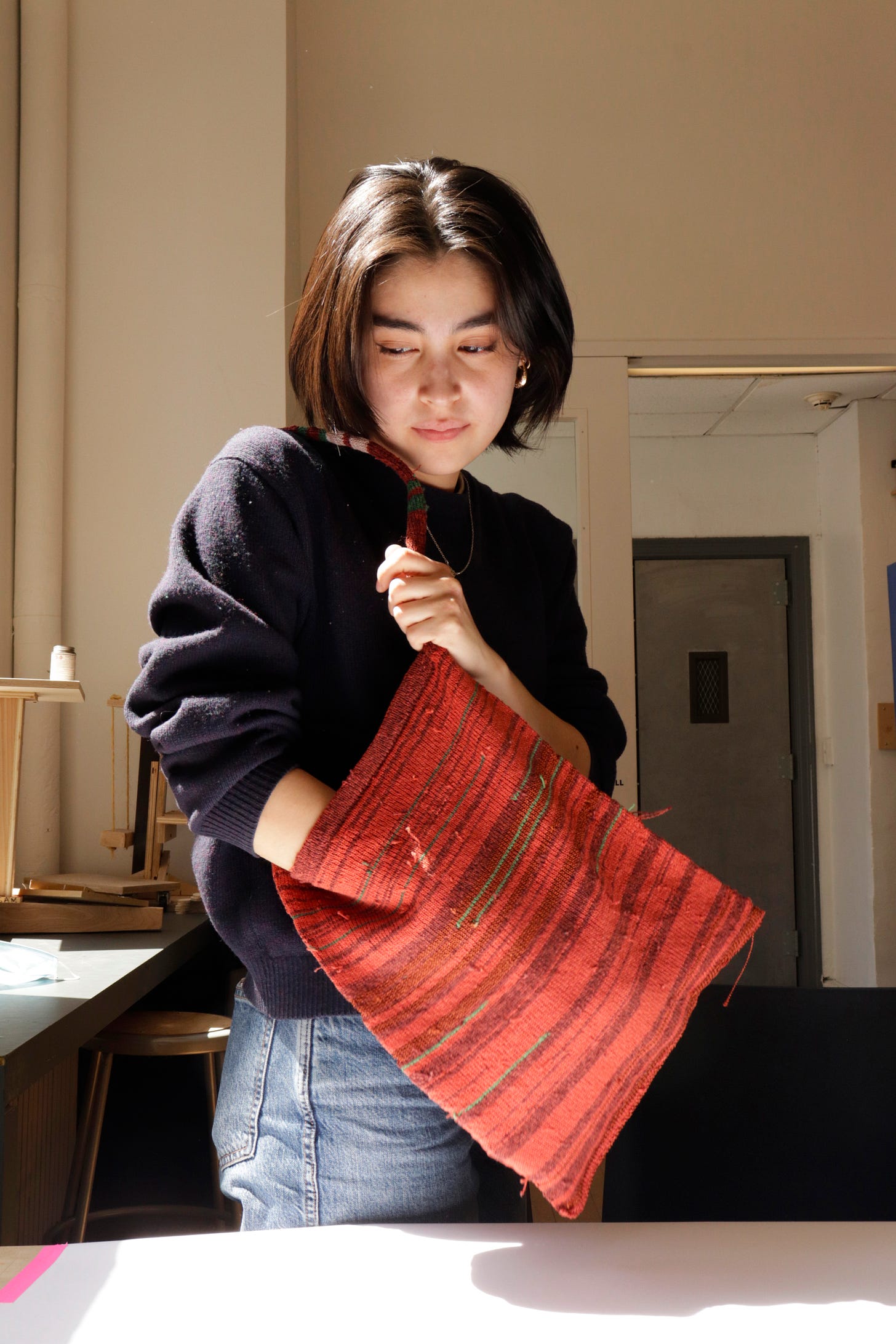Welcome to Objectively #29! Object Talks is a sub-series on conversations with creatives who work with objects—such as makers, collectors, and curators—about their practice.
Emma Cali was introduced to me by Thana (#22), and I was taken to her material explorations, from undoing knitwear to binding found objects into matchbox-sized books. In the interview, Emma comes alive with her passion for material sustainability and a call to action that reminds us the promise of finding community through craft.
I feel like her words I can keep returning to to uncover more lessons and find points of connection, the way she breathes new life into everything she touches.
Emma Cali is a multimedia designer and artist whose practice is deeply rooted in the transformation of found material and industry waste scraps into new, functional objects. Her current work combines her technical training in Industrial Design with process-based research of textile waste streams to explore the effects and ethics of our material world and how things are made.
Emma sees both her art and design work as a way to critically engage with the climate crisis and the human experience within that, seeking potential and joy in all that she sees and makes.
What got you into material sustainability?
My interest in material and manufacturing sustainability really stems from an inability to create in good conscience without its consideration. The design process I’m striving towards is one that develops a methodology that embraces form follows function while not becoming sterilized by the process and efficiency.
A formative text in my design education was “Design for the Real World” by Victor Papanek. In my eyes then, his essentialist take on design was virtuous and holy, and I believed to some degree that that was the purest form of making. A really famous project of his was the “9-Cent Radio” in which the components of the product were widely accessible waste scraps: a tin juice can, paraffin wax and a wick. Together, they created a fully functioning radio receiver, the construction plans open to the public domain to use (specifically in third world countries with limited technology access). Allowing the geo-political climate and resource accessibility to form one’s output made complete sense, but I struggled to contextualize that for myself and the projects I was given whilst in university.
I was really taken by the responsibility instilled in a designer, having awareness and attentiveness towards what one has and what others need, and at times I felt kind of guilty about my proclivity towards making things that did not serve such dire circumstances. This text inspired me greatly to assess the importance of material and manufacturing as it evolves in time, while also addressing my own personal strengths and aesthetics in art and design.
With Undone, you deconstructed and reconstructed knitwear, finding potentials and limitations of materiality. What did you learn from that?
This project definitely held a plethora of both literal and metaphorical findings. I had never conducted a project like this, nor did I really have guidance or other project methodologies to look towards, so in hindsight there are a ton of things I would have added, expanded on, and tailored a little differently.
As a materiality exploration, I wish I had emphasized the sourcing process by casting a wider net for places to scavenge, as well as the range of material I played with before selecting a method of deconstruction and reconstruction. The material I chose had little to no stretch, and I really put my knitting machine through it (sorry machine). Exploring other options could have provided other product outcome options, but I was short on time and resources, so it’s something I have been planning to explore in the aftermath.
A piece of sustainability that I think is super important is accessibility and scalability. I felt a bit defeated that the project would have major limitations of its impact in those two categories due to its intensive labor, but I also found a lot of power and joy in that. Every piece of fabric was pulled apart and knotted by hand by not only myself, but members of my community. I had friends who so graciously shared their time in support of the project, as well as strangers who took interest in the idea. Although the ultimate goal is to one day contribute to a project that has much wider reach, I found a lot of value in experiencing how much support these ideas can have even when they are not perfect and fully formed, and the importance of community and asking others for help.
What’s something people should know about pre- or post- consumer textile waste?
I suppose we all know the statistics of textile waste and its gargantuan numbers in landfills, so I’ll spare us from any lecture of what we already know and looms heavy over us.
I think what I’m always searching for is a community of other makers who are just exploring and trying things out, and I want to encourage people to reach out and connect with others who enjoy exploring any realm of making.
There is such a rich history of community bonding through knitting circles and other craft-based projects; it's a way to know your neighbors, spread news and important information, gently rely and trust those around you. I see it more commonly in older generations, but I suppose I’ll leave this here as a call to action: if you are a maker of any kind, continue to use it as a way of connecting with people around you. There are so many instances where my friends and I don’t even really talk, but make in parallel. It's often the way I reach out to others, and you should too!
Given your exploration with different materials and ideas, I’m wondering if anyone has associated “play” as central to your approach, and what you think about this?
Oh boy do I love to play! As I think many artists and designers can relate, it’s often the key to a flow state that allows me to transition into a thoughtful work process. I sometimes think there’s a misconception of what play really is as it’s not at all childish, rather a display of comfort and sense of freedom to explore whatever comes to me in the moment — the relinquishment of judgment. There is so much potential and opportunity everywhere, and as a young artist and designer I keep myself very open and fluid to all the things that make my pupils dilate.
I find it essential to find people and spaces I feel comfortable to play with and in. It’s not just critical to my design approach, it’s the backbone of my community. The people I play with are the people I trust to tell me how they feel, show me what they mean, make honest mistakes with, and vice versa. Play is just living freely and being human, and accepting that. In design, it is the grounds for fruitful teamwork and innovation, and I’m always really honored when I find a true new playmate!
I love that - the relinquishment of judgement. What’s something you’ve been experimenting with lately?
Book binding have a bit of a strong hold on me right now, although they’ve been a consistent love of mine since I was a kid. Miniature books, secret folders and detachable components - they kill me! I often find inspiration for new projects through random objects I find when I’m out and about, or from what others find for me - my people know me well.
I’m very into hand sewn bindings at the moment — variations on coptic stitches in particular — and I often use used or found materials mainly because I find it satisfying to create a cohesive collection of eclectic and unadulterated objects and also, there will certainly be nothing like it.
Some examples of my work include a book where the covers are old keyboard caps (the end result was oddly long and kinda squirmy), little matchbook books lost and found on the way home from the bar, or binding medical documents that were once ‘me’ but are now just a sign of the times.
I’ve also made miniature versions of my design portfolio, all encased in descending file folders in a little hardcover case. I just love the feeling of a multifaceted, interactable assemblage; I never want my works to feel stagnant. These are all exercises of ideas at various stages, but I love how they all look when sat together in a little box, a real treasure trove of misfit toys.
A lot of my works place emphasis on the meaning of the found objects to me, but also hope to leave room for new life and usage for others as all are also functional objects. They are meant to be made with integrity so they don't sit on a shelf, but can be loved and used and filled with ideas unrelated to their initial creation.
As a Repair Technician at Patagonia, what’s been the most memorable project you’ve worked on so far?
I had the chance to go down to the Patagonia SoHo retail location where one of the original repair hubs now formally lived, and trained with two of their incredible employees Clara and Kat.
I spent the day learning how to deconstruct and replace baffles on Down Sweaters and sew patches on Nano Puffs, getting a chance to understand how Patagonia intakes and structures their repair services on such a large scale. I used the Aston Martin of sewing machines, aka a high grade industrial Juki machine that nearly changed my life, and got to play with scrap material galore. Can’t think of a better day's work.
What does a dream project or partnership look like for you?
I think what I’m still trying to determine is my place on the faultline between art and design, and how to make a living from that. Finding the place and playmate(s) to create a studio that fuses interdisciplinary art and design practices would be a real dream.
At the moment, I feel like I have so much I want to learn from others before venturing out on my own, so working for larger companies like Patagonia or Nike on the material innovation and product development and research side is a big goal. Either that, or a mentorship somewhere remote where we just make like crazy. Whatever it is, I learn best from doing, so working jobs in all different situations both big and small are fruitful in my eyes.
I see the path towards my career as a giant circle with large sweeping arches paving the way. It’s not just materiality that really drives my inspiration at the moment, but the people and space I’m surrounded by too. I honestly can't imagine a single project or cap to place on it just yet. I hope I just keep meeting people who love what they do immensely, and we come together to make something that doesn't really exist yet.
Before you go, who’s another object-creator that you enjoy or find inspiration in? If given the chance, what’s one question you’ll ask them?
I’m really inspired by the team set-ups as well as project approaches of creators like Studio Swine and Neri Oxman.
Studio Swine has this ocean plastic stool where they film the whole process from start to finish of going out on a fishing boat, collecting the plastic, forming it, and the final product. These types of conceptual projects focusing on material, making process, and human engagement are really exciting; I find their holistic approach as artists and designers not bound by category, but rather fluid in their creative endeavors and thought processes to really embody the dream.
Same for Oxman, her teams work out of the scientific method and design, pushing the frontier of form following function to a whole new level through biology.
My one question would be: What does it realistically take to start and sustain such experimental design studio practices, and what practical advice would you give to young designers hoping to create one one day?
Follow Emma’s explorations on Instagram and view her work on her website.
Hi to our new subscribers from the
comments section! is one of my favourite writers so to have this connection with some of you here feels special. I hope you’ve enjoyed this first edition you’re receiving and feel free to leave your thoughts in the comments or hit reply!Also, I missed posting last week as I took on a freelance photography project for a food brand that took more of my time than I’d anticipated. I’m newly juggling a job search + freelance life so please forgive me if I miss a week here and there. Thanks for being here, your support means a lot. See you next week!












